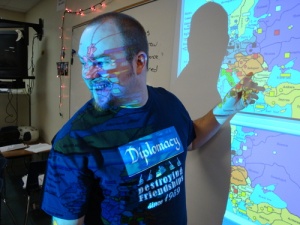This is an “article” about a teacher’s use of the boardgame “Diplomacy” in his 12th grade humanities classroom (who had just read Sun Tzu’s “The Art of War and Machiavelli’s “The Prince”). I ran across this “article” awhile back when I was searching for examples of the use of existing games that have been used to teach topics in a real classroom. I put quotes around the word “article” here because the work is not a published article but appeared in the form of a very long post on the “Boardgame Geek” forum. As such there is no indication of the real name of this person or where his school is located. In the opening paragraphs of his post he identifies himself as a teacher and states the following:
“This is written by a teacher, about a teacher’s experience using the game in the classroom, for an audience who is either interested in general in the world’s best game, or for teachers who are looking toward using gaming to enrich their instruction.”
 The poster (Calavera Despierta) includes great detail and photographs of his efforts to teach his students the game and apply it to the lesson he his hoping to teach them. He also goes to great lengths to analyze and give a detail debrief of his success. I find the narrative fascinating and all the more so when one reads that this brave teacher actually did this simultaneously in four of his classes.
The poster (Calavera Despierta) includes great detail and photographs of his efforts to teach his students the game and apply it to the lesson he his hoping to teach them. He also goes to great lengths to analyze and give a detail debrief of his success. I find the narrative fascinating and all the more so when one reads that this brave teacher actually did this simultaneously in four of his classes.
Calavara address many concerns that I have seen in other published accounts about using games in the classroom such as:
- The time it takes to teach the game and the use of class time to do so as well as play the game.
- Dealing with students who don’t “get into it” or just are non-participatory
- Running simultaneous games
- Gender issues with girls maybe not being as involved as boys (especially in war themed games)
- The pitfalls of competition and (especially in this game) the pitfalls of Machiavellian behavior in the game that may carry out of the game.
- How to actually make the game meaningful and apply it to the topic being taught.
Calavara does a good job explaining in detail how he deployed the game and how he attempted to address these issues. I wish he had (or will) think about publishing his reflections on his experience. In the meantime I highly recommend reading his post here:
Diplomacy in the Classroom: A Massive Report
And then read his follow-up post about some of the written reflections of his students after experiencing the game in his classroom here:
Diplomacy in the Classroom: Part 2: Kids in their own words